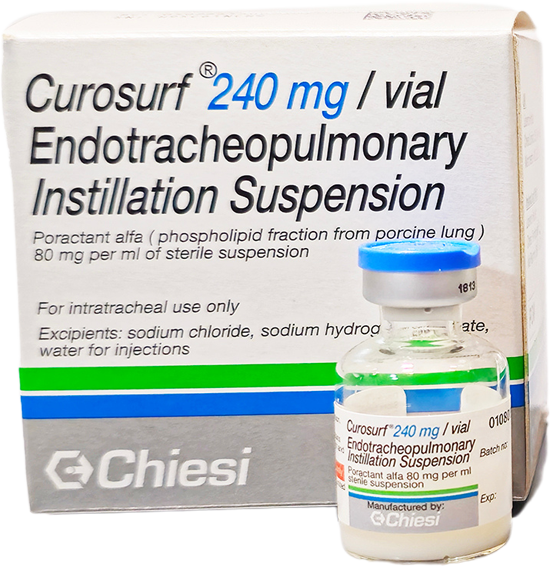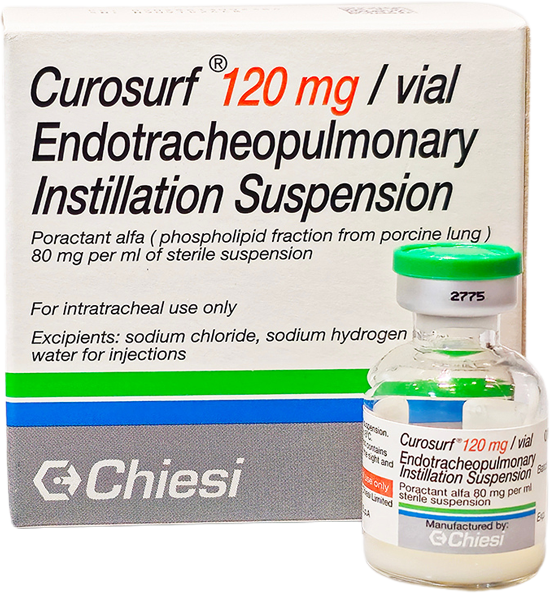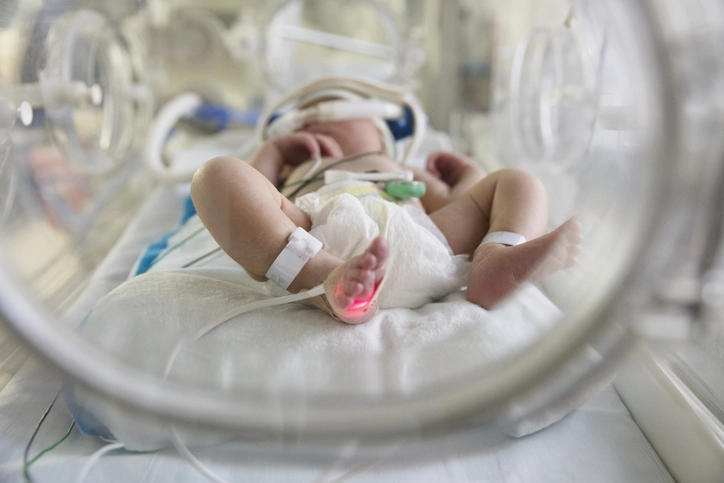CUROSURF: helping you transform
RDS outcomes
CUROSURF is a recommended option in neonatal care, supported by extensive research and global clinical use.1,2
Central to Chiesi’s 30-year legacy in neonatology, it has transformed the management of neonatal RDS, significantly improving survival rates and respiratory function for millions of infants worldwide and establishing itself as a cornerstone of neonatal care.3,4
Key facts about CUROSURF
- CUROSURF has a natural composition resembling human surfactant and provides more than double the lipid concentration (mg/ml) of other exogenous surfactants, significantly improving respiratory function in infants with RDS2,6,7
- A natural surfactant prepared from porcine lungs, containing almost exclusively polar lipids — in particular, phosphatidylcholine, a crucial lipid for lowering surface tension within the lungs2
- Contains around 1% of the hydrophobic proteins, SP-B and SP-C, which work with surfactant lipids to help reduce surface tension2,8
- Licensed in the UK for use in infants of any gestational age and weight who are at risk of developing RDS or have a surfactant deficiency2


The European Consensus Guidelines award their highest level of recommendation (A1) for:1
- The use of an animal-derived surfactant preparation
- The use of CUROSURF at a dose of 200 mg/kg versus other preparations at a 100 mg/kg dose
CUROSURF is indicated for:2
CUROSURF is indicated for:2
- The treatment, including early rescue, of respiratory distress syndrome (RDS) or hyaline membrane disease in newborn infants
- Prophylactic use in premature infants at risk of developing RDS or with evidence of surfactant deficiency
CUROSURF should only be administered by those trained and experienced in the care, resuscitation and stabilisation of preterm infants. CUROSURF is administered via the endotracheopulmonary route in infants whose heart rate and arterial oxygen concentration or oxygen saturation are being continuously monitored (as per usual practice in neonatal units).2

Neonatology Education,
Skills and Training
Chiesi is committed to advancing medical education with innovative and comprehensive training programmes, aiming to equip HCPs with the essential knowledge, skills, and expertise to thrive in the dynamic field of neonatology.
In investing in your professional growth and staying at the forefront of a rapidly evolving medical landscape!
The history of CUROSURF:3,4
In 1959, Avery and Mead discovered that ‘hyaline membrane disease’ was caused by insufficient production of pulmonary surfactants, leading to its renaming as RDS
Early surfactant replacement trials failed because they only contained phospholipids and were insufficiently administered via nebulisation
Bengt Robertson and Göran Enhörning demonstrated that natural surfactant, containing both phospholipids and proteins, could improve RDS symptoms in immature rabbits
Bengt Robertson and Tore Curstedt developed a porcine surfactant, CUROSURF® (named after their surnames). It proved effective in immature animals and was used in a pilot clinical trial starting in 1983. The first trial in 1985 showed that CUROSURF reduced pulmonary air leaks and neonatal mortality in preterm infants with severe RDS. A second trial by Christian Speer demonstrated that multiple doses of CUROSURF were more effective than a single dose.
In 1992, CUROSURF was introduced as a treatment for neonatal RDS
To date, more than 30 years after its introduction, CUROSURF has been given to an estimated 4-5 million infants, with at least 1 million of them surviving because of it. Currently, between 300,000-400,000 premature infants are treated with CUROSURF every year.
Watch the video below demonstrating the history of CUROSURF.
Abbreviations
ECG, European Consensus Guidelines; RDS, respiratory distress syndrome; SP, surfactant protein.
References
- Sweet DG, et al. European Consensus Guidelines on the Management of Respiratory Distress Syndrome: 2022 Update. Neonatology. 2023;120(1):3–23.
- CUROSURF SmPC. Available at https://www.medicines.org.uk/emc/product/6450/smpc. Accessed September 2024.
- Karolinska Institutet Innovations AB. Available at https://ki.se/en/collaboration/industry-collaborations/20-years-of-innovation-karolinska-institutet/the-man-who-has-saved-the-lives-of-a-million-babies. Accessed September 2024.
- Curstedt T, Halliday HL, Speer CP. A Unique Story in Neonatal Research: The Development of a Porcine Surfactant. Neonatology 2015;107(4):321–329.
- Ma C C-H and Ma S. The role of surfactant in respiratory distress syndrome. The open Respiratory medicine journal2012;6:44–53.
- Survanta SmPC. Available at https://www.medicines.org.uk/emc/product/834/smpc. Accessed September 2024.
- FDA: Infasurf. Available at https://www.accessdata.fda.gov/drugsatfda_docs/label/2011/020521s024lbl.pdf. Accessed September 2024.
- Han S and Mallampalli RK. The Role of Surfactant in Lung Disease and Host Defense against Pulmonary Infections. Ann Am Thorac Soc 2015;12(5):765–774.
IE-CUR-2400039 | December 2024
Adverse event reporting
For the UK: Adverse events should be reported. Reporting forms and information can be found at https://yellowcard.mhra.gov.uk/ or search for MHRA Yellow Card in the Google Play or Apple App Store. Adverse events should also be reported to Chiesi Limited on 0800 0092329 (UK) or PV.UK@Chiesi.com.
For Ireland: Adverse events should be reported to HPRA Pharmacovigilance – www.hpra.ie. Adverse events should also be reported to Chiesi Limited on 1800 817459 (IE) or PV.UK@Chiesi.com.